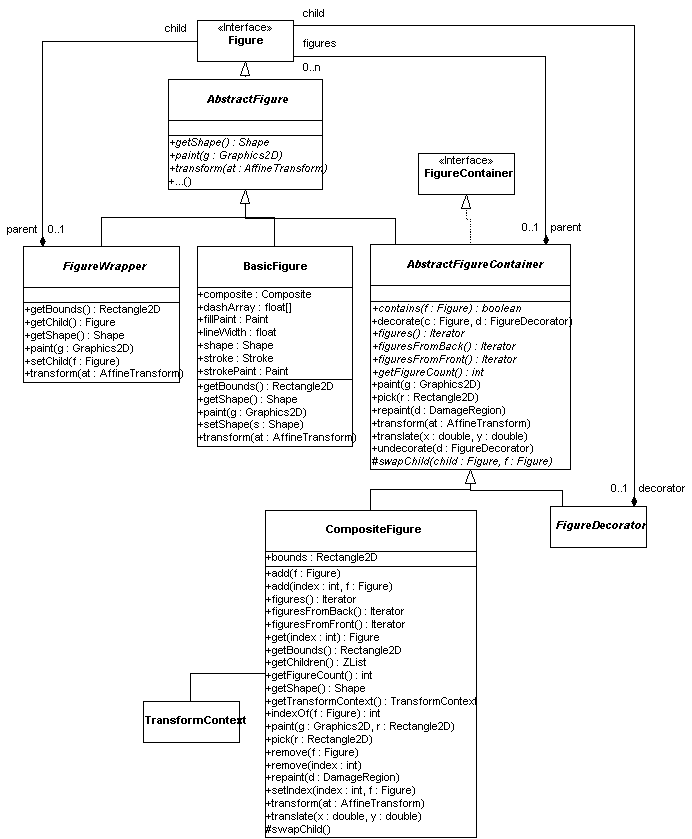|
|
The figure classes
The Figure interface roots a small tree of abstract and concrete classes
that provide the framework for defining figures.

The root class is AbstractFigure, which provides default
implementations of all methods defined in Figure and its ancestor
interfaces except for the getShape(), paint(), and transform()
methods. AbstractFigure is the correct class to extend for
user-defined leaf figures. Diva provides examples of this in
diva.canvas.toolbox and diva.canvas.tutorial, of which
one, BasicFigure, is shown on the class diagram.
BasicFigure is a useful concrete figure that, in effect, allows
you to turn a Shape into a Figure. As such, it has setShape() and
getShape() methods, and several properties (accessed through
JavaBeans-style setter and getter methods) for the outline paint and
line style, and for the fill paint and transparency. Note that this
class only draws a single shape; for more complex figures, clients are
expected to create their own concrete subclasses of AbstractFigure.
FigureWrapper is a Figure with the sole purpose of wrapping other
figures. Sometimes, you will need to define a Figure class that has
some kind of application-specific behavior, but you don't want to tie
the visual representation too closely to the application. In that
case, subclass FigureWrapper and give your subclass the
application-specific methods needed, and in your client code, set the
child of the wrapper to provide the visual
appearance. FigureWrapper overrides several methods in AbstractFigure
to forward requests to the child figure.
AbstractFigureContainer extends AbstractFigure, and is the root
class for figures that contain other figures. It provides default
implementations of paint(), transform(), and translate(), all of which
forward the call to each of the children. It also provides default
implementations of some of the methods defined in the FigureContainer
interface, excepting contains(), figures(), figuresFromFront(),
figuresFromBack(), and getFigureCount(). In addition, it defines an
abstract protected method swapChild(Figure, Figure), which subclasses
must override to replace a child with another (this is used by the
decorate() and undecorate() methods.)
There are two subclasses of AbstractFigureContainer.
CompositeFigure is a container that contains its children in a z-list,
and implements a slew of methods that add, remove, and find child
figures. The z-list can be accessed by the getChildren() method. It
also defines a new transform context, so that its children are
positioned relative to that context. CompositeFigure is thus the most
general form of composite figure. If you require a composite figure
that restricts access to its children, then you should subclass
AbstractFigureContainer directly and implement your own child
management.
Finally, FigureDecorator is a special kind of figure container that
contains exactly one child, and is described in the next section.




|



